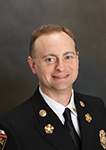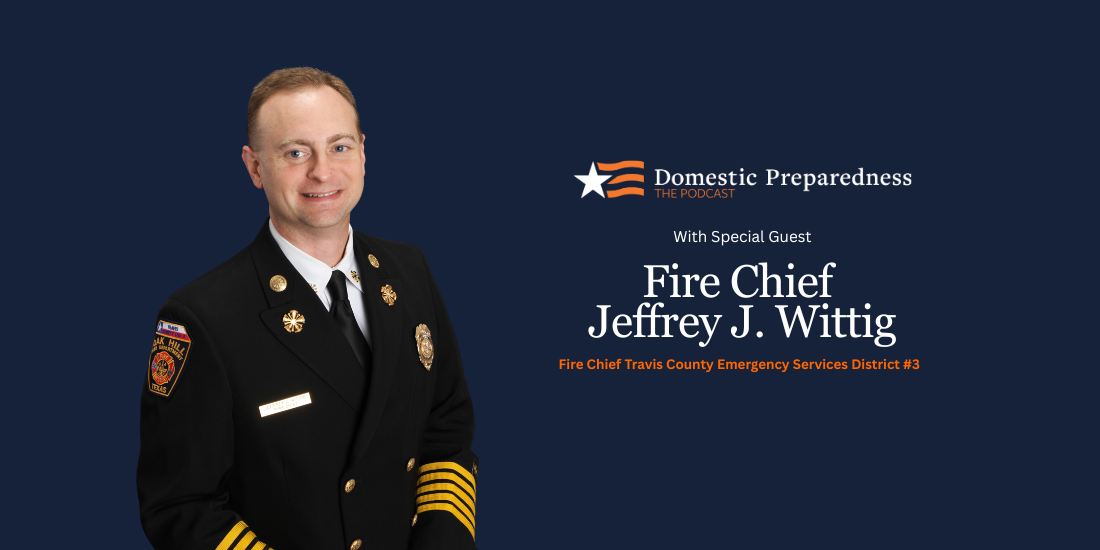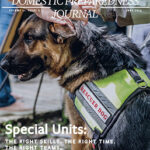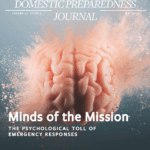This is an interview with Fire Chief Jeffrey J. Wittig, a podcast by Domestic Preparedness, June 25, 2025.
Fire Chief Jeffrey J. Wittig has served the Oak Hill Fire Department in his role since January 2012, after beginning his service as a volunteer firefighter in 1996 and rising through the ranks. He is currently the state coordinator for the Texas Intrastate Fire Mutual Aid System (TIFMAS), president of the TIFMAS Foundation, and sits on the executive committee of the Texas Emergency Management Advisory Committee.
Wittig holds advanced certifications from the Texas Commission on Fire Protection, is a licensed EMT, and completed leadership programs including the National Fire Academy’s Executive Fire Officer Program, the Texas Fire Chiefs Academy, and the Governor’s Center for Management Development at UT Austin. He maintains his designation as a chief fire officer through the Center for Public Safety Excellence and serves as a peer evaluator.
Wittig earned a bachelor’s degree in psychology from the University of Texas at Austin and an M.B.A. from the University of Phoenix. He is an Eagle Scout and remains active in his church and community.
Learn about Chief Wittig’s passion for service and emergency response.
Nicolette Casey Phillips
Hello and welcome to Domestic Preparedness the Podcast, where we bring you the voices of preparedness. I’m your host, Nicolette Casey Phillips, and in this episode, we’re diving into the critical issues of the emergency preparedness field. We are talking to leaders in the field, experienced practitioners, and dedicated officials who are shaping policies and practices to strengthen community preparedness across the country. With me today is fire chief at Travis County Emergency Services, district No. 3, Fire Chief Jeffrey J. Wittig. Okay, let’s start with your background. Can you tell us a little bit about your career path and how you became involved with TIFMAS?
Chief Jeffrey J. Wittig
Sure. Well, I’d like to say it’s unique, but I have a feeling it’s, it’s not at all. So I began, I’ve been with my department the entire time of my career, but I started as a volunteer. So it came from wanting to help in the area where I live, driving past a fire truck, driving past an emergency scene and thinking there’s something about that that appeals to me because I want to help, not at all thinking that I had any skill or ability to help, but I had this drive, right? I see that there was a need, and someone helped fill it. And wouldn’t that be a neat thing to be able to give back to a community, to humanity, really.
Casey Phillips
That is so beautiful.
Wittig
So I just started there with, I had this desire. And from that I had other career aspirations. I never thought I would do firefighting or anything in the fire service as a career. I never intended that, but I got into it, and that was after I had achieved a college degree, gotten a job, gotten married, and said, “This is something I really want to do.” And with the support of my family, my wife, she said, “Well, if it’s something you need to do, then go do it. And so, and again, that was, that was where we lived. It was my own community, so I wasn’t going far. It was just down the road.
Casey Phillips
You were serving your community.
Wittig
I was indeed and so that’s, that’s how I started. It was just volunteering, and while that may sound easy to say and seem like not much to it, I can tell you there’s a whole lot behind it. And the volunteers that serve this state specifically, outstanding people. To be in a position to not only be able to give, but to want to give of their time and their assistance and their resources.
Casey Phillips
I can tell you have a servant’s heart, Chief.
Wittig
I try to. That’s, I think that’s something that should drive most all of us. It’s a matter of, how much can you do? How much will you do?
Casey Phillips
I think that’s what we all have in common.
Wittig
Indeed, I think we do too. So for me, it transitioned into having attained a higher-level college degree. I got, had a master’s degree. My department, I’d been volunteering with for some time said we really need some help administratively, which tended to fit a little bit of what I was doing. So I decided to, to make the make the jump. I took, I took a bit of a pay cut, but got to work where I live. And got to keep helping in different ways. And that’s really something I’ve learned throughout that whole process, is there’s not just one way to help. There’s not just one mechanism to push a button on to go do something. There’s many different ways people, in whole, can help someone else.
Casey Phillips
I appreciate that perspective, because I think our audience needs to hear that.
Wittig
Absolutely, I would easily tell you there’s something for everybody in emergency management and emergency response. There’s something you can do somewhere for someone.
Casey Phillips
Even me?
Wittig
Absolutely, you’re doing it right now.
Casey Phillips
Chief!
Wittig
Well, you are.
Casey Phillips
I love that.
Wittig
You should.
Casey Phillips
I feel humbled just by that statement.
Wittig
That, and I would tell you, that’s also another feeling that accompanies most everything we do, is to realize you’re in a position, you’re in a place to go affect, help, give assistance to someone, and when you can do that, there’s nothing more humbling about what it is that we do on this earth than to go help somebody else.
Casey Phillips
That’s right. That’s beautifully said. Excellent. Now looking back, is there anything that prepared you for this role in a way that you didn’t expect?
Wittig
Oh, boy, that’s a big question. It is. There are probably so many things that have affected me, from how I was raised. My parents—I went through the Scouting program. So, very much service-centered type of thing. In school, I played in the band. So in doing those things, you, you give a lot, you spend a lot of time doing things that, okay, you may enjoy it, but there’s also an enjoyment for other people, right? So there’s always a way to see how you can affect and impact others, and everything you’re doing.
Casey Phillips
That’s so true.
Wittig
And so through that, through my, my faith and my church family, there’s just, there’s kind of never-ending. My former supervisors, jobs I’ve had previously while I was volunteering, working full-time as my first full-time job, there was always support, and honestly, even support from our own state government, because I worked for a state agency, another higher education, and part of the state legislation back then, little bit way back when for me, was, I had access to free time off to go train up to two weeks a year, which is pretty substantial when you think about it. And then I was actually able to miss regular work if we had an incident, had an emergency. The—granted, you had to be kind of right place, right time, for that to really trigger. But I knew I had that support, not just from my supervisors, but from my employee entity, from my state.
Casey Phillips
I think as a whole, it’s very supportive in this atmosphere to continue advancing your experiences and continue, you know, with certifications and training. This is a family here who truly believe in leveling up and finding your place.
Wittig
And you do that every day,
Casey Phillips
And you do that every day. That’s right. I love that.
Wittig
It’s, it’s one of those things where we, when you get stagnant on what you’re learning or experiencing, you stop putting yourself in position to make a difference somewhere. So for me, two days in a row of not learning something new, that’s a bad stretch. I have to fix it. So I would encourage all of the folks out there to keep that drive going, no matter what it is you’re doing or how routine you think your job may be day to day, you’ve got to find something new to learn or experience about it every day. And the truth is, the world isn’t waiting for us. There’s changes happening every day.
Casey Phillips
Especially here with us, here in this field, every day, every second, if anything. We chit-chatted prior to us sitting down, because we’re old pals now, and you mentioned something that may stick with me beyond this exhibit hall, and maybe stick with me for the rest of my life. You said it’s not so much about where you see yourself in five years. It’s where you see your field in maybe ten years. And I feel like we can all apply that to everything we do, but within this field, it’s essential to apply it, to be able to look towards the vision, towards the future, so that we better know how to prepare and what we have on hand, or the possibilities in general.
Wittig
That’s right, and I think that’s the, to me, became the key of five years is just too quick. To me, it didn’t challenge my, when I thought about it for myself, it didn’t challenge me enough, because five years from now, I can, I can kind of contemplate pretty easily. We’re near some things as though I could just imagine it—okay in five years, it probably happened. But 10 years from now, and what really made it click for me personally was when I hit the rewind button instead of fast forward. So 10 years from now, what do I think it might look like? Well, let me just kind of compare what did I think things were going to be 10 years ago compared to today? And one of the things I mentioned is electric vehicles. Well, sure, there was somebody dabbling in it, but it wasn’t anything we really ever thought we’d see on the roads, probably not in my career span, maybe not my lifetime. And here we are, less than 10 years later from that point, for me. They’re all over the place, and we’re still learning every day about them and about how our field has to respond to them. So we’re learning through that. 10 years from now, I think we’ll have a pretty good mindset about what to do with electric vehicles. But the question is, what’s the next newest thing 10 years from now, where we’ll need to be learning even more new things again, while we’re still polishing and brushing up on the things from today and from 10 years prior.
Casey Phillips
Love that. Now, for those who may not be familiar, what is TIFMAS, and what makes it unique here in Texas?
Wittig
I’m glad you asked. Yeah, so TIFMAS is the Texas Intrastate Fire Mutual Aid System. And in essence, it’s just a program where we find local resources to mobilize and deploy to go help other areas in our state. And while it’s built that way and designed that way and even named that way as intrastate, it’s designed to be within Texas, we do dabble a little bit in interstate. We have gone out of state to assist other states.
Casey Phillips
As us Texans do.
Wittig
Indeed, we do and, and likely because we tended to be pretty good at it with a state this size and the number of emergencies we see or things that we at least know we have to be planning for and prepared for. The program was built and designed to handle all of the things that happen in Texas. And as we know, you can have 3, 4, 5 different, completely different types of emergencies and disasters occurring across the state all at the same time. And so our program, the TIFMAS program, was put in by state legislature in 2007. Our first deployment occurred in 2008. We haven’t stopped. We’ve, we’ve just been ramping up, scaling up. It’s a phenomenal program, in my opinion, Right now we’ve got nearly 300 departments specifically registered in the system. That doesn’t mean the others aren’t participating. It just means maybe they haven’t filed the paperwork to renew or something like that. Over 11,000 individual personnel registered on the all-hazards site.
Casey Phillips
Oh, wow. That’s a big number, Chief. I wasn’t expecting to hear that.
Wittig
It is a big number. Now again, what’s important to remember, the entire TIFMAS program has zero employees. Doesn’t employ a single person. TIFMAS is, is just a group. We are supported and managed by the Texas A&M Forest Service and our own Texas Division of Emergency Management team, and I say our own because we’re here at their conference today.
Casey Phillips
That’s right. Shout out.
Wittig
That’s right. So, so and there are multiple other stakeholder groups, state agencies, statewide organizations that all serve as kind of the sounding board to make sure our policies or procedures, the way we conduct our “business” is done efficiently, effectively, safely—obviously, safety being the, kind of the biggest factor. That’s the reason we have to have all of those things, but, but the program itself doesn’t actually employ anyone. We are all, myself included, we’re all just local government workers. I’m a fire chief in a fire department in Central Texas, but I do this on the side. I don’t get paid extra for this. Nobody’s looking.
Casey Phillips
You just find it important.
Wittig
I do, and I will tell you that the majority of those 11,000 people registered in the system, and certainly the seven regional coordinators and myself and our state deputy coordinator—we do it because we believe so strongly in this program. Probably not a surprise, Texas is in legislative session right now. We spent a bit of time at the Capitol this year, and it’s one of the things when I visit a congressperson’s office, legislator’s office, and I tell them if the representative or if the senator or if anyone in their office has a question about our program, please call me, because I love to talk about it. And I tell them, quite honestly, I think it’s one of the best things we do in this state. Well, we know here at the conference, it’s Team Texas, and that’s absolutely what we live every day. It’s Team Texas. That’s what we do. So when Texas has a need, Texas steps up. That’s right, and that’s at the local level, going into the state level and back down. It’s, that’s just how the system works. And so our program, having that, notably, of that 11,000 people, we’ve got about 5,500 that are specific in the wildland environment. And that’s maybe a little bit more where we had our roots, where we really started was on the wildland side. That 5,500 responders puts us fourth in the nation in the size of wildland-credentialed responders in an agency. So we’re a force just a bit, and we’re certainly, we’re not there to displace others. And as all of our emergency management partners know, all emergencies start local. And, and our whole goal, our whole job, is to come in and just boost your resources, give you that extra that you need. Because we’ve all been there. I’ve been there certainly in my own department. We’re a small department. There are things I cannot do alone. And so we have to get over the “This is my turf and my boundary, and I don’t share it,” and we’ve moved way past that. This program has probably been instrumental in that for a number of locations, to help understand, it’s okay that you can’t do it alone. And then when you reach into your neighboring departments, your mutual aids, that you normally do, there’s a point where there’s not enough resources still.And so it’s imperative that our emergency management community know that a program like TIFMAS exists because we’re your local partners. We just might be a little further away than you’re used to seeing. You maybe don’t have our number in your phone, but that’s okay. When you run it through the state, they know how to get us, and through our coordinators, we build that, that relationship with our local departments to know who has the resources available, who can probably go and help. And we just gather those resources and send them down range. When they get there, they’re working for the local jurisdiction. They’re not there taking over. They’re there to just be more support when you don’t have enough resources on your own. It’s just more resources. We’re just depth on the bench.
Casey Phillips
I love that. Now, how does that impact local departments during high-stress activations?
Wittig
Well, I will tell you, I think, and certainly from the feedback we’ve gotten from, from other folks in the field, it’s one of those things that’s almost hard to describe. So when you’re in the thick of it, when you’ve got those incidents running, and they’re taxing your resources, or—wildland site is one perspective. But again, the all-hazards, our group is responding to tornadoes, floods, hurricanes, or anything else that comes up. That’s really one of the beauties of how the program was built, is, if there’s a need, and there’s a local government somewhere in the state that has it, if there’s no other way to get it there, the TIFMAS program can make that happen. We have the mechanism in place to just find it and get it to you through the state. They, they know, okay, well, there’s something exists over here. The mechanism to make it happen is through this program. And so when we can arrive to a local jurisdiction and help, it’s, it’s life-changing. It really is. The things that you’re, you’re worried about, “I can’t accomplish this. I can’t make the ultimate difference in stopping this emergency,” whatever it is, “I can’t rescue all the people in time. I can’t get them out of the flood waters. I can’t get them from a collapsed building,” whatever it may be, when you have more resources it, it just makes it all possible again. And so you’re not, as a local jurisdiction, in the heat of it. You’re not battling that doubt. I don’t have enough to do what I know I need to do. Well, now you do have enough, and we can all work together and make it happen. And again, falling back to the Team Texas environment, so much of this is all about teamwork, and even though our resources from my department in Central Texas may go to the Panhandle on a wildfire, may go to the coast for a hurricane. We’ve done those things. We’ve never met those people, may not have even heard of their department. They probably haven’t heard of mine, but that’s okay. We’re vetted. We, we have training. We, we know what it is we’re about to go step into, and we’re there to help make a difference, help make it better. That’s all we can ask for, is to just try to help make it a little bit better than it was before we got there.
Casey Phillips
Is there a challenge when you look back to your career that maybe wasn’t thought of and maybe after that, let’s say, disaster, y’all learned a lot from?
Wittig
Well, I would, I would tell you that that probably even doesn’t have to be a major disaster. Again, kind of, the beauty of how emergency management, emergency response works, is you learn something on every single event.
Casey Phillips
Yeah, and on the fly.
Wittig
On the fly. Well, we often joke, you go in with Plan A, but that’s really what you’re formulating, as soon as you get notification you need to go help somewhere. That’s Plan A. By the time you’re in the vehicle moving, you’re on plan B or C by then. By the time you arrive, you’re probably F, G.
Casey Phillips
J, K, L, M, N, O, P!
Wittig
Yes, and 30 seconds later, you’re into double, yeah, double character. You’re in AA because it just changes so rapidly. And certainly, when you arrive and you can put your eyes on something, you see it differently than what you envisioned. So therefore, everything’s always changing. So I would say the program actually helps. This is one of the things when I present about it, that I talk about, is, there’s no better way to get this experience than to just go do it. And, and for my local jurisdiction, if we’re going to experience something on a disaster level, when is the first time it’s most convenient for my people to have seen it, for the people that are responding in the vehicles, responding in the EOCs? When’s the first time you’re going to feel comfortable that they’re experiencing that? When it’s happening to your own people in your own community? Or have they already had experience elsewhere when they go help? So when you go help someone else, you’re actually building your own personnel, your own staff much better to handle it when it happens at home.
Casey Phillips
That’s a really good point. Thank you for that. Now, what is one piece of advice you can share with our listeners and our subscribers that you wish you could have known earlier in your career? Oh, that’s a good one! If you need to think, Chief…
Wittig
No, no, that’s all right. It’s really not hard to get to. It is a good, challenging question, but it’s not hard to get to really. And it’s just, if I had realized how much every single thing we do impacts our experience, I probably would have paid a lot more attention to those things early on in my volunteer service time, and then as I transitioned into full-time in my department, I think if I had paid a little bit more attention, I could have learned so much more in the moments. Now I can reflect back and think about the things that I can remember, but I still feel like I’ve probably missed some opportunity to learn something else every step of the way.
Casey Phillips
Thank you so much for that, Chief. We’re going to leave our audience on that note now. Thank you so much for your time.

Jeffrey J. Wittig
Fire Chief Jeffrey J. Wittig has served the Oak Hill Fire Department in his role since January 2012, after beginning his service as a volunteer firefighter in 1996 and rising through the ranks. He is currently the state coordinator for the Texas Intrastate Fire Mutual Aid System (TIFMAS), president of the TIFMAS Foundation, and sits on the executive committee of the Texas Emergency Management Advisory Committee.
Wittig holds advanced certifications from the Texas Commission on Fire Protection, is a licensed EMT, and completed leadership programs including the National Fire Academy’s Executive Fire Officer Program, the Texas Fire Chiefs Academy, and the Governor’s Center for Management Development at UT Austin. He maintains his designation as a chief fire officer through the Center for Public Safety Excellence and serves as a peer evaluator.
Wittig earned a bachelor’s degree in psychology from the University of Texas at Austin and an M.B.A. from the University of Phoenix. He is an Eagle Scout and remains active in his church and community.
- This author does not have any more posts.






